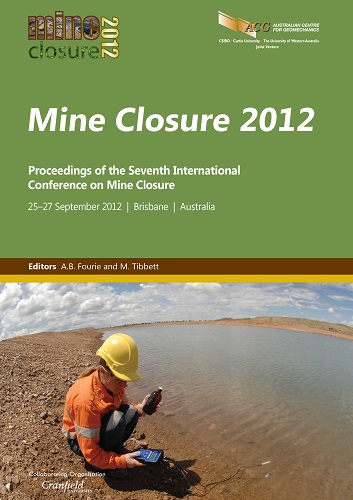Leading practice waste dump rehabilitation at the Ginkgo mineral sands mine

|
Authors: Squires, H; Priest, M; Sluiter, I; Loch, R |
DOI https://doi.org/10.36487/ACG_rep/1208_07_Loch_Squires
Cite As:
Squires, H, Priest, M, Sluiter, I & Loch, R 2012, 'Leading practice waste dump rehabilitation at the Ginkgo mineral sands mine', in AB Fourie & M Tibbett (eds), Mine Closure 2012: Proceedings of the Seventh International Conference on Mine Closure, Australian Centre for Geomechanics, Perth, pp. 59-71, https://doi.org/10.36487/ACG_rep/1208_07_Loch_Squires
Abstract:
Bemax Resources Ltd operates the Ginkgo mineral sands mine located 35 km west of Pooncarie in far western New South Wales. Large ‘start-up’ overburden stockpiles are present at the mine site and will remain after closure. The first overburden stockpile to be constructed and revegetated is overburden stockpile OB3, which covers an area of 34 ha. Material characterisation studies by Landloch Pty Ltd provided detailed information on runoff and erosion potential of the outer batter slopes, underpinning recommendations with respect to batter profiles, heights, and gradients, and surface treatments such as placement of tree debris to control wind and water erosion. Associated trials have shown the value of tree debris in reducing impacts of sand movement on emerging seedlings. Perimeter and cross bunding to manage runoff from the top of the landform were also recommended. Soil stripping operations have followed a two-step process, using tractors towing laser scoop buckets to ensure accurate collection and placement of topsoil and subsoil layers. Stockpile management aimed to minimise deterioration of topsoil properties, though significant changes in a range of soil parameters have been documented, leading to some modification of existing practices. Vegetation studies guided development of seed mixes for direct seeding, which was carried out using a dozer-mounted drum seeder able to work through the tree debris. The initial seeding shows excellent stability to erosion, and observations have confirmed the importance of perimeter bunding. Initial soil and vegetation monitoring confirms establishment of a chenopod shrubland vegetation at the desired indigenous plant cover levels, but has identified a need for improvement of soil fertility in subsequent rehabilitation operations (continuing improvement is essential). Data from the various stages of design, rehabilitation and monitoring are presented to illustrate the range of areas to be addressed if rehabilitation is to be successful.
References:
Benson, J.S., Allen, C.B., Togher, C. and Lemmon, J. (2006) New South Wales Vegetation Classification and Assessment: Part 1 Plant Communities of the NSW Western Plains, Cunninghamia 9(3), pp. 383–450.
Flanagan, D.C., and Livingston, S.J. (1995). Water Erosion Prediction Project (WEPP) Version 95.7 User Summary. In ‘WEPP user summary’, Flanagan and Livingston (eds), NSERL Report No 11, July 1995.
Renard, K.G., Foster, G.R., Weesies, G.A., McCool, D.K. and Yoder, D.C. (coordinators) (1997) Predicting Soil Erosion by Water: A Guide to Conservation Planning with the Revised Universal Soil Loss Equation (RUSLE), U.S. Department of Agriculture, Agricultural Handbook 703, 404 p.
© Copyright 2025, Australian Centre for Geomechanics (ACG), The University of Western Australia. All rights reserved.
View copyright/legal information
Please direct any queries or error reports to repository-acg@uwa.edu.au
View copyright/legal information
Please direct any queries or error reports to repository-acg@uwa.edu.au